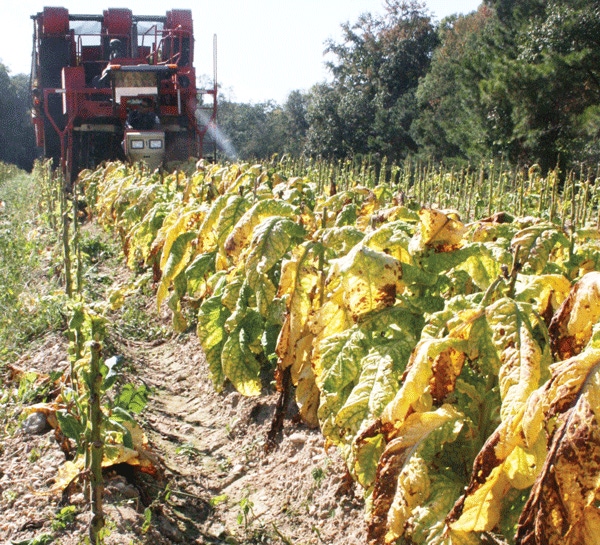
Tobacco varieties tested during 2010 growing season
• Tobacco growers were forced to keep harvesting much longer after the point of optimum maturity than they normally would this year, and much of the crop wasn’t harvested until well into October, which is quite late.• The intense heat and sporadic drought delayed the maturity of much of this year’s tobacco crop, especially in Virginia and North Carolina.
November 11, 2010

As his mechanical harvester reached the end of his last row of tobacco late in the afternoon of Oct. 12, Randy Edwards of Wendell, N.C., breathed a sigh of relief that his tobacco variety — K 326 — has excellent holding ability.
That is, it can hold its weight and quality for an extended period of time after the point of optimum maturity.
That was just what flue-cured growers like Edwards needed in a season like 2010. The intense heat and sporadic drought delayed the maturity of much of the crop, especially in Virginia and North Carolina. Farmers were forced to keep harvesting much longer after the point of optimum maturity than they normally would, and much of the crop wasn’t harvested until well into October, which is quite late.
In this situation, K 326 came in very handy.
“If it lives, K 326 is an excellent tobacco in October,” said Edwards. “It holds a lot better on a later crop like this one.”
Unfortunately, K 326 has a drawback: It has almost no disease resistance, and none to black shank. “Sometimes it seems that K 326 has to go on land that hasn’t had tobacco on it for 30 years!” Edwards joked. “Seriously, you need a lot of rotation and a low level of disease, and even then, you still have to use Ridomil and a multi-purpose fumigant. So we need alternatives to K 326.”
There are some good candidates. Edwards likes NC 196 because of its good disease resistance package and high yield and quality. And itsholding ability is very close to K 326, he said.
Has always done well
“K 326 has always done very well for us in yield, holding ability and curing quality, and it has been a staple on this farm for about 20 years,” said Joey Scott of Kenly, N.C. “But we are in a Granville wilt hot spot, and we look for resistance to it and other diseases.”
Scott and his brother Gary have tried out about 20 alternative varieties in the last few years, but they can’t seem to find one that will take K 326’s place.
“It is a struggle to find disease resistance in a variety and have good yield and holding quality too.”
But he has one he likes. It is called PVH 1452, and it looks promising, he said. “PVH 1452 is a real good variety. It has good Granville wilt resistance, and its holding ability has been satisfactory.”
But it didn’t hold up as well in the 2010 heat as some of the other varieties they plant.
So the search is still on for varieties with holding ability. And they are continuing disease control methods other than variety choice. “On our hottest (Granville wilt) fields, we extend our rotation as long as possible. We rotate with soybeans and cotton over four or five years.”
The main disease problem for Donnie and Brent Boyette, also of Kenly, N.C., is black shank. “NC 196 is pretty high in resistance to Race 0 black shank, and because of its other characteristics, we plant a lot of it.
“We also have a little problem with tobacco mosaic,” said Donnie Boyette. “This year, in those fields, we used CC27, which is resistant to mosaic. We had NC 71 in those fields last year, and it was eaten up.”
K 326 was the other of the Boyettes’ three primary varieties.
“Under the conditions we had this year, NC 196 did by far the best of all our varieties. It got off to an early start and continued to grow, and it held up late. It was the first we planted and the last we planted. And we learned that buyers like it.”
The hot weather didn’t just affect their variety choice. The Boyettes topped a little early this season, when the plants were knee high. They also modified their sucker control somewhat based on the conditions.
“We sprayed with Fair 85, then we Prime Plus-ed it,” said Donnie. “We tried to delay applying MH as long as possible, so we could give it all the chance to fill out that we could. We didn’t know what else to do, other than to keep the tops out of it,”
Their normal sucker control program is three applications of a contact, then two quarts of Prime Plus with MH 30 10 days later.
Two first-year burley varieties appear to have made a good impression in 2010.
• KT 209 has the highest level of resistance to both strains of black shank of any variety now grown in this country. Where black shank pressure is low, KT 209 should perform comparably to 204 and 206, says Paul Denton, Kentucky/Tennessee Extension specialist. But in fields with black shank, 209 will do much better.
• KT 210 features moderate resistance to fusarium wilt and high resistance to both races of black shank. It will probably be most popular in areas of Kentucky and North Carolina where both diseases are a problem.
In addition, some farmers may grow it for its quality characteristics. “You can demonstrate slightly better quality for KT 210 than for KT 204 or KT 206,” said Denton. “But it is not a whole lot better.”
You May Also Like



